Recent Posts
SERVPRO® of Jonesboro Offers NEW Cleaning Service
6/13/2024 (Permalink)
 “Restore- Don’t Replace.” with SERVPRO of Jonesboro.
“Restore- Don’t Replace.” with SERVPRO of Jonesboro.
SERVPRO of Jonesboro is excited to announce that we are offering a NEW service! We are now certified Esporta operators!
SERVPRO of Jonesboro is known for our mitigation and cleaning services when it comes to items such as furniture (tables, desks and chairs,) but in homes and businesses that have been affected by a fire, water, mold and mildew, there are many soft textiles (linens, curtains, drapes, bedding, clothes that were hanging in closets) that were often damaged beyond our scope. These items would then be sent to an outside vendor for cleaning.
Now with the Esporta Wash System, SERVPRO of Jonesboro will be your one stop for cleaning of unique articles like sports equipment, household goods and a wide variety of clothing, including leather. This will provide 24 hour turnaround time on emergency items, resulting in happy customers! Insurance companies can benefit by using an Esporta certified company as it significantly reduces claim settlement costs by keeping the entire job “in-house” at SERVPRO of Jonesboro.
The Esporta Wash System utilizes hydraulic action to force contaminants out of the objects to be cleaned. The Hydraulic Action process utilizes chambers, or pockets, inside the drum, and items are placed in these pockets, held in place, and rotated. Proprietary detergents and water complete this patented and revolutionary cleaning process, guaranteeing the best, and safest, cleaning and restoration in the industry. Items that would have been previously deemed non-salvageable can now be restored! Laboratory results indicate that this process is five times more effective than traditional washing machines!
The motto of the Esporta system is “Restore- Don’t Replace.” And we couldn’t agree more at SERVPRO of Jonesboro. By offering this new service we’re aiming to provide quick turnaround and recover sentimental items that may have previously been lost due to extreme damage. This is just another way that we are working to always improve our restoration services and be the best in the game!
Tips from the SERVice PROfessionals: Protecting Your Property from Storm Damage
5/7/2024 (Permalink)
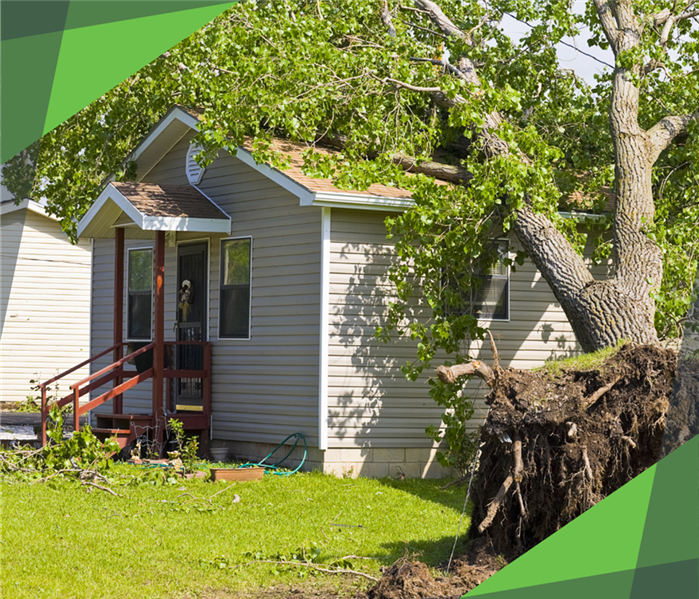 Trees and branches pose a significant risk during storms; thus, regular trimming can prevent potential damage to your property.
Trees and branches pose a significant risk during storms; thus, regular trimming can prevent potential damage to your property.
Protecting your property from storm damage is a critical concern for homeowners and businesses alike. As experts in restoration services, we understand the challenges and fears that come with facing natural disasters. Our aim is to provide you with professional advice and empathetic support to help mitigate the risks associated with storms. By taking proactive steps, you can significantly reduce the likelihood of enduring costly and emotionally taxing damages.
Firstly, it is essential to conduct regular inspections of your property. This includes checking the integrity of roofs, windows, and doors, which are the primary barriers against storm elements. Ensuring that these features are in good condition and properly sealed can prevent water from entering your property. Additionally, clearing gutters and downspouts is crucial to avoid water buildup that can lead to roof and foundation damage. For those in particularly vulnerable areas, investing in storm shutters or high-impact glass can offer an extra layer of protection against high winds and flying debris.
Another critical aspect is the maintenance of the surrounding environment. Trees and branches pose a significant risk during storms; thus, regular trimming can prevent potential damage to your property. Securing or storing outdoor furniture and decorations can also minimize the risk of these items becoming projectiles. Understanding your local flood risk and considering appropriate defenses, such as sandbags or permanent flood barriers, can be invaluable. Lastly, ensure that you have an up-to-date insurance policy that covers storm damage, providing you with peace of mind and financial protection.
As restoration experts, our commitment extends beyond the repair process. We are dedicated to empowering our clients with the knowledge and tools necessary to protect their properties and loved ones from the unpredictability of storms. We’re driven to understand and address your concerns, ensuring that you feel supported throughout every step of the preventative and restoration journey. Remember, preparation is key to resilience, and by taking these proactive measures, you can safeguard your property against the elements and minimize the impact of storm damage.
SERVPRO of Jonesboro
3025 Peabody Drive | Jonesboro, AR 72404
(870) 934-0501 | SERVPROjonesboro.com
#jonesboro #jonesboroarkansas #likeitneverevenhappened #heretohelp #SERVPROjonesboro #arkansas
The SERVice PROfessional's Tools of the Trade
4/5/2024 (Permalink)
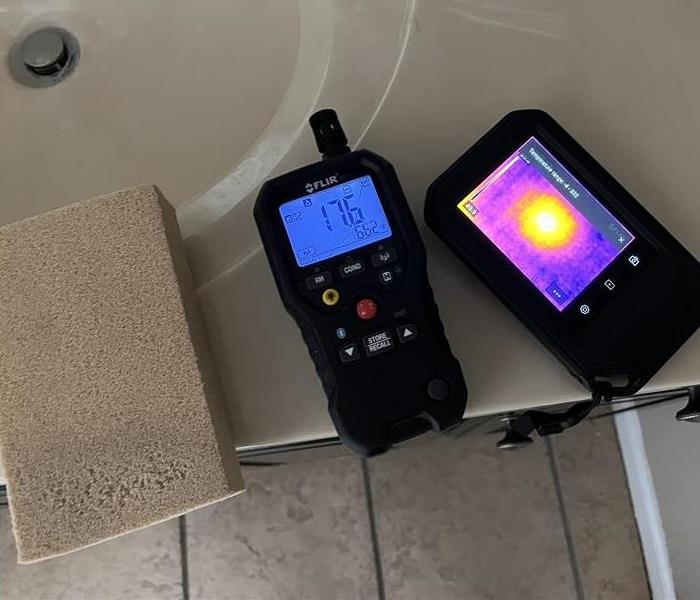 A dry sponge, moisture meter and infrared camera are common tools of the trade when working fire and water jobs.
A dry sponge, moisture meter and infrared camera are common tools of the trade when working fire and water jobs.
As experts in the field, we understand the importance of using high-quality equipment to ensure efficient and effective restoration work.
One of the key tools of the trade when assessing water damage is a moisture meter. A moisture meter is a device that is used to help accurately measure the percentage of water, wetness or dryness, within a given material. Moisture meters can be invasive or non-invasive, meaning they do not have to penetrate the material. At SERVPRO of Jonesboro we use moisture meters with separate thermo hygrometers, meaning that while the moisture meter checks for wetness/dryness, the thermos hygrometer checks the temperature and relative humidity.
Another essential tool is an infrared camera. Infrared cameras are non-contact devices that detect thermal energy and then convert it into an electrical signal, which is then processed to produce an image. Infrared technology uses temperature to determine moisture, cooler temps indicate the material is wet while higher temps are dry. The term FLIR (which stands for “Forward Looking Infrared”) refers to the technology used to create an infrared image of a scene without having to “scan” the scene with a moving sensor, which is what was previously required. A moisture meter is always used to confirm the findings made with an FLIR camera.
A dry sponge is used to test for soot particles after fire damage and are ideal for cleaning surfaces where you can’t use water or solvents. By swiping the sponge across surfaces, we can see the accumulation of particles. A black or brown discoloration is indicative of fire-related particles and white or light gray is normal house dust. The uniqueness of the sponge is all in the cell structure, it is a vulcanized, non-toxic, natural latex rubber sponge. When the product was invented, it was called a chemical sponge, because, at the time, chemicals meant more cleaning power, but there are no actual chemicals within the sponge, and they are entirely safe for use on delicate surfaces.
These are just some of the tools we used every day at SERVPRO of Jonesboro. Investing in the right tools of the trade not only enhances the efficiency of our work but also showcases our expertise and commitment to restoring properties with care and precision.
Tips from the SERVice PROfessionals: Protecting Your Property from Water
3/11/2024 (Permalink)
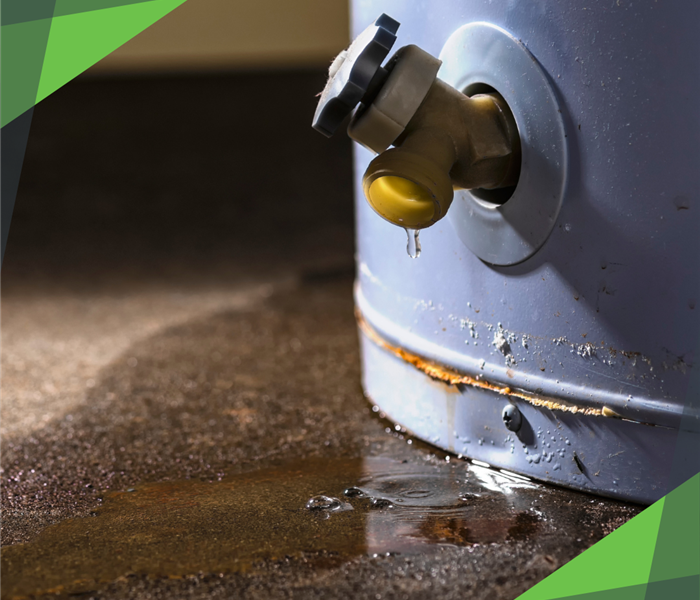 One of the key ways to prevent water damage is to regularly inspect your plumbing system.
One of the key ways to prevent water damage is to regularly inspect your plumbing system.
Water damage can be a homeowner's worst nightmare, causing not only financial strain but also emotional distress. As experts in restoration services, we understand the importance of prevention when it comes to water damage. By taking proactive measures, you can safeguard your home and belongings from potential harm.
One of the key ways to prevent water damage is to regularly inspect your plumbing system. Check for any leaks, drips, or signs of corrosion in pipes, faucets, and appliances. Addressing these issues promptly can help avoid more significant problems down the line. Additionally, installing a leak detection system can provide an early warning in case of any water-related emergencies.
Another crucial step in water damage prevention is proper maintenance of your home's exterior. Make sure your roof is in good condition, with no missing or damaged shingles. Clean out gutters and downspouts regularly to prevent water from accumulating and seeping into your home. Proper grading around your property can also help ensure that water flows away from the foundation, reducing the risk of flooding.
Remember, a little prevention now can save you a lot of headache later on.
SERVPRO of Jonesboro
3025 Peabody Drive | Jonesboro, AR 72404
870-604-4725 | www.SERVPROjonesboro.com
Renew, Restore, Revitalize: Your PROfessional Construction Company
2/21/2024 (Permalink)
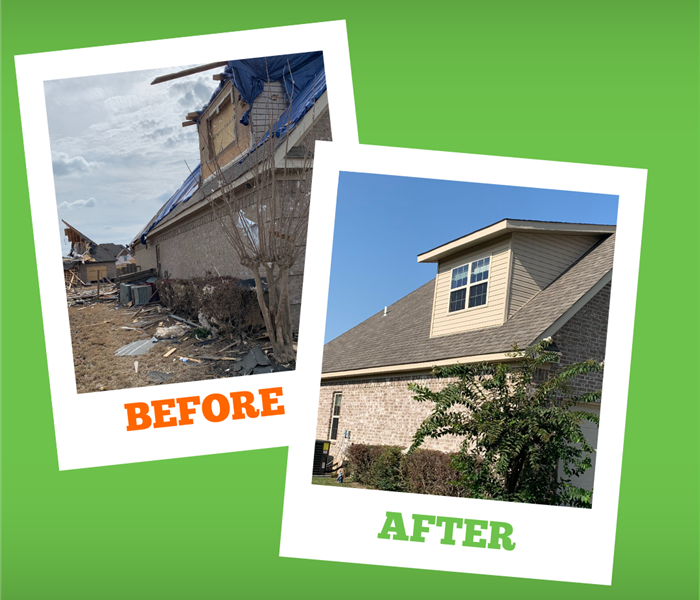 We specialize in reconstruction after events such as a fire or tornado.
We specialize in reconstruction after events such as a fire or tornado.
When it comes to your construction needs, trust the experts at SERVPRO of Jonesboro. We have held a commercial contractor’s license for over 4 years in the state of Arkansas. This qualifies us to handle all local residential and commercial construction needs.
Our team of professionals are dedicated to providing top-notch services that exceed expectations and breathe new life into your home or business. We specialize in reconstruction after events such as a fire or tornado, by replacing roofing, siding, windows, doors, flooring and painting. We can also provide remodeling services for rooms like kitchens and bathrooms.
Whether you are looking to renovate a single room or revamp your entire property, our expertise in the field ensures that every aspect of the construction process is handled with care and precision. From initial consultation to the final touches, we are committed to delivering exceptional results that not only meet but exceed your needs. Let us guide you through the journey of renovation with our years of experience, making the process as smooth and stress-free as possible.
At SERVPRO of Jonesboro, we take pride in being a trusted authority in the construction industry. We have a passion for quality craftsmanship and are here to help bring your vision to life. Trust in our expertise and let us show you the transformative power of professional construction services.
Tips from the SERVice PROfessionals: Protecting Your Property from Fire
2/1/2024 (Permalink)
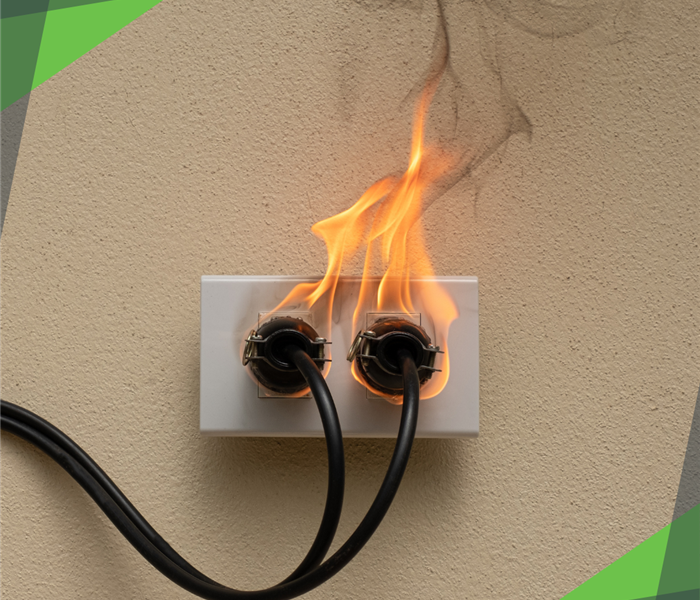 Pro Tip: Avoid overloading electrical outlets and extension cords and ensure that all appliances are turned off when not in use.
Pro Tip: Avoid overloading electrical outlets and extension cords and ensure that all appliances are turned off when not in use.
Although we are a fire and water restoration company, we would rather you prevent fires at your home and business. It is the best way to ensure the safety of your loved ones and your property. Fires can strike at any moment, and it is crucial to take the necessary steps to prevent them from happening. In this blog, we'll provide you with some valuable tips on how to keep your home and business safe from fires.
The first and most important step is to make sure that you have functioning smoke detectors installed throughout your home. Smoke detectors are the first line of defense and can alert you and your family in case of a fire. It's important to test them regularly and change the batteries at least twice a year. Because alarm sensors wear out, it is recommended to replace them at least every 10 years
Another important step is to avoid leaving cooking unattended. The kitchen is one of the most common places for fires to start, so it's essential to be cautious when cooking. Make sure that all flammable items are kept away from the stove and oven.
It's also important to have a fire extinguisher readily available in case of an emergency. Make sure that you know how to use it and that it is within reach. Furthermore, avoid overloading electrical outlets and extension cords and ensure that all appliances are turned off when not in use.
Remember that prevention is always better than restoring. By taking the necessary steps to prevent fires, you can ensure the safety of your loved ones and your home. Stay safe, and don't hesitate to contact us for any restoration needs.
SERVPRO of Jonesboro
3025 Peabody Drive | Jonesboro, AR 72404
870-934-0501 | www.SERVPROjonesboro.com
SERVPRO Safety: Water and Mold Remediation; ladder usage, electrical encounters
1/8/2024 (Permalink)
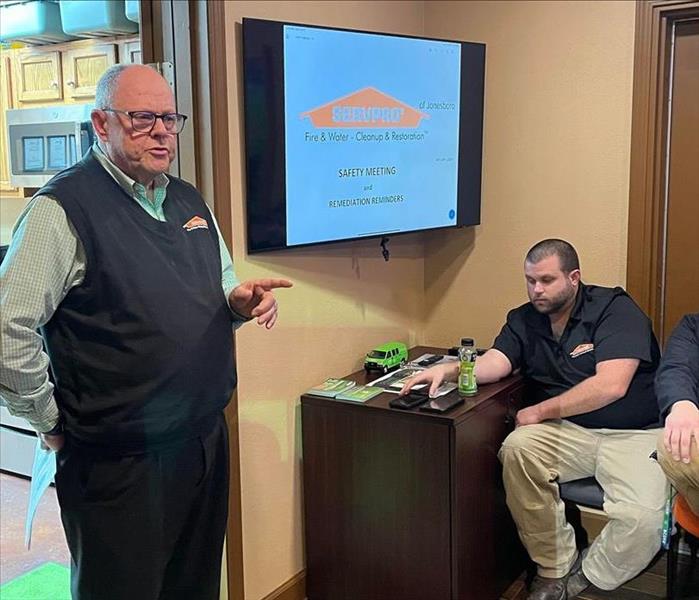 Steve Singleton, our construction manager, discussing different SERVPRO safety procedures.
Steve Singleton, our construction manager, discussing different SERVPRO safety procedures.
Our SERVPRO mitigation and reconstruction teams held a safety meeting at the start of the year to go over remediation reminders and protocol to safely handle water and mold jobs as well as general safety of using ladders and electrical encounters.
If a water loss is considered to be category 3 by a crew leader- meaning the water is grossly contaminated, containing bacterium, viruses, toxigenic (poison) or other harmful agents that can cause adverse reactions, our team will always wear required PPE such as gloves, boots, coveralls (Tyvek), eye protection and masks. HEPA air filtration (air scrubbers) and HEPA vacuuming will be required, with the possibility of containment of the area.
HEPA is a type of pleated mechanical air filter. It is an acronym for "high efficiency particulate air [filter]" (as officially defined by the U.S. Dept. of Energy) Filters meeting the HEPA standard must satisfy certain levels of efficiency.
If mold is present at a jobsite, containment and PPE will be required along with HEPA air filtration (negative air) and HEPA vacuuming with the possibility of using a HEPA air scrubber. SERVPRO crew leaders will take the lead in identifying the level of containment, getting approval, and implementing PPE and documentation.
Our construction manager, Steve Singleton, will be contacted for mold consultation. He has extensive knowledge in the industry due to his 12 IICRC certifications including: Master Water Restorer, Master Fire and Smoke Restorer, and Residential Mold Inspector. He also has 2 OSHA Health and Safety certifications and is a Licensed Asbestos Inspector.
There are 5 levels of mold contamination, depending on the square foot of infestation. At 10 square feet of affected area, it is recommended to call a removal company to handle the clean up SAFELY. We would never want you to put yourself in danger. It’s best to let a professional handle a situation such as this. You can trust SERVPRO of Jonesboro to follow all the required protocols necessary to handle any unsafe water losses and mold infestations.
If you experience an emergency water loss or suspect mold, call us today to set up an inspection.
SERVPRO of Jonesboro
3025 Peabody Drive | Jonesboro, AR 72404
870-604-4725 Office | www.SERVPROjonesboro.com
What are "soot tags?"
1/3/2024 (Permalink)
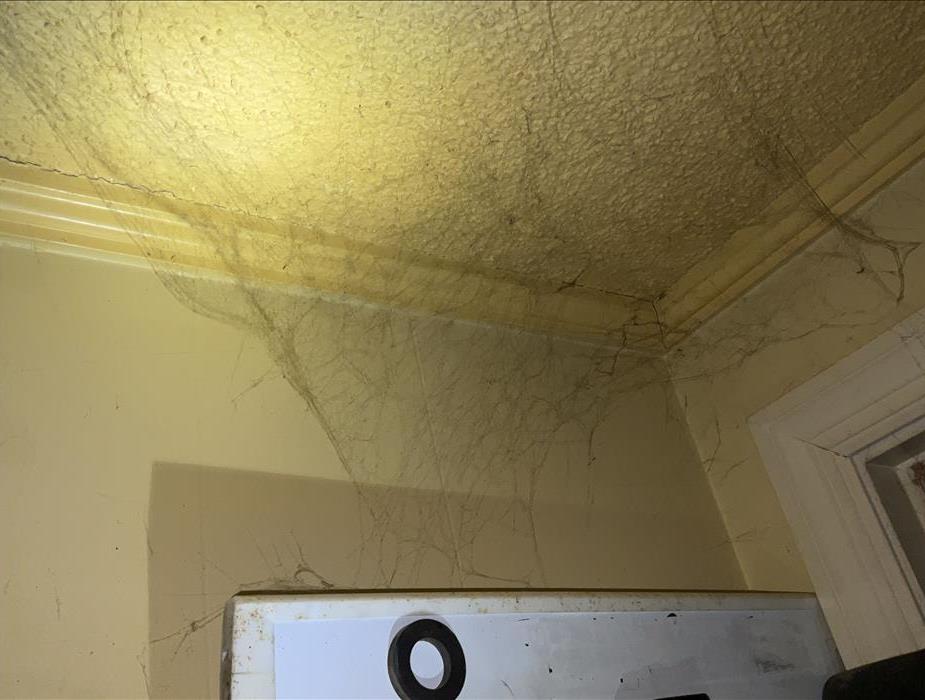 As fire restoration & remediation specialists, SERVPRO of Jonesboro pros are used to seeing the unique and often creepy appearance of soot tags.
As fire restoration & remediation specialists, SERVPRO of Jonesboro pros are used to seeing the unique and often creepy appearance of soot tags.
We all know what soot is: black smudge that often follows a fire, big or small, inside your home. You may have seen it after a candle loses its flame or the last ember dies out in your fireplace. However, when cleaning up an emergency fire’s aftermath, you may notice a strange string of web-like chains across your wall.
At first glance, it may look like you might have a spider infestation on your hands. For those with arachnophobia, don’t worry—these soot webs are actually strings of carbon and tar released from a fire called “soot tags.” To help ensure you understand how to clean up a soot-related mess, here’s a quick digest of everything you need to know about these fake spider webs or soot webs:
What are soot tags?
As fire restoration and remediation specialists, SERVPRO® of Jonesboro professionals are used to seeing the unique and often creepy appearance of soot tags. More commonly called “smoke webs” or “smoke cobwebs,” these patterns occur in low circulation areas after a fire. As the heat circulates into colder spaces, soot particles follow in chain-like formations and create webbed structures.
How should I clean up soot tags?
Cleaning up after a fire can be tricky, and you probably want to get started right away. Still, the most critical thing to remember is to wait until professionals have cleared the space before entering.
Spending any amount of extended time in an area that’s recently had a fire can expose you to lingering soot and smoke. These particles can cause long-term damage to your health, among other concerns. Those with compromised immune systems or respiratory issues should take extra care to avoid these spaces.
After a fire, SERVPRO® of Jonesboro team members will work with firefighters and other professionals to determine when it is safe for you and your family, colleagues, or friends to reenter a building. A thorough inspection by professionals before cleanup begins will help give you the peace of mind that the environment is safe and ready for entry.
Now it’s time to get rid of those pesky soot webs. In many cases, it’s recommended that you enlist the help of professionals to get rid of your soot damage—but we’ll get to that in a moment. For a small, soot web, try the following:
- Basic cleaning: use a mixture of dish soap, warm water, and a soft sponge to gently work away the soot webs. Soot tends to feel greasy, and excess agitation can cause more damage or stains.
- Melamine sponges (Magic Erasers®): known as the magic tool of cleaning, melamine sponges are an inexpensive tool that helps remove tricky stains.
- Remember to gently scrub as you clean: any harsh chemicals or movement can create an even greater problem.
When should I call professionals for help?
If the methods mentioned above aren’t doing the job, consider calling in the professionals. At SERVPRO® of Jonesboro, we offer comprehensive fire damage cleanup and remediation to get you back in your home or space as quickly as possible.
SERVPRO of Jonesboro
3025 Peabody Drive | Jonesboro, AR 72404
870-604-4725 Office | www.SERVPROjonesboro.com
Winter Warmth: A Guide to Winter Fire Safety
12/14/2023 (Permalink)
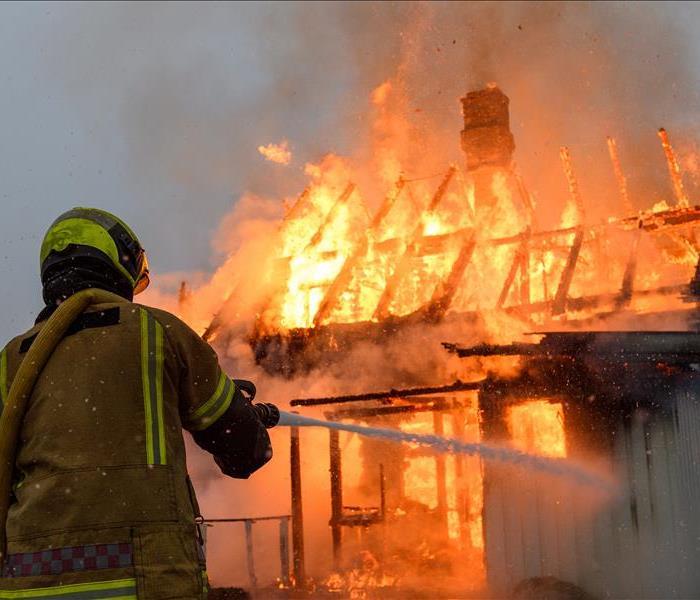 Did you know that heating equipment is one of
the leading causes of home fire deaths?
Did you know that heating equipment is one of
the leading causes of home fire deaths?
Did you know that nearly half of home heating equipment fires are reported during the months of December, January & February?
Heating equipment is one of the leading causes of home fire deaths. Fire departments responded to an estimated average of 44,210 fires involving heating equipment per year from 2016-2020, accounting for 13% of all reported home fires during this time, and these fires resulted in annual losses of 480 civilian deaths.
Heating fire facts:
Based on 2016-2020 annual averages:
- Space heaters were the type of heating equipment responsible for the largest shares of losses in home heating equipment fires, accounting for one-third of the fires, but nearly nine out of ten deaths and four out of five of the injuries in home fires caused by heating equipment.
- Fires originating in a kitchen or cooking area accounted for the largest share of home heating fires (17%).
- While the larger (non-confined) fires involving fireplaces or chimneys were involved in fewer than one in ten fires caused by heating equipment (7%), they caused just over one-fifth of the direct property damage (22%).
- Nearly half of the heating equipment fires (46%) occurred in the three-month period from December through February.
With a few simple safety tips and precautions you can prevent most heating fires from happening. Be warm and safe this winter!
- Keep anything that can burn at least three-feet away from heating equipment, like the furnace, fireplace, wood stove, or portable space heater.
- Have a three-foot “kid-free zone” around open fires and space heaters.
- Never use your oven to heat your home.
- Have a qualified professional install stationary space heating equipment, water heaters or central heating equipment according to the local codes and manufacturer’s instructions.
- Have heating equipment and chimneys cleaned and inspected every year by a qualified professional.
- Remember to turn portable heaters off when leaving the room or going to bed.
- Always use the right kind of fuel, specified by the manufacturer, for fuel burning space heaters.
- Make sure the fireplace has a sturdy screen to stop sparks from flying into the room. Ashes should be cool before putting them in a metal container. Keep the container a safe distance away from your home.
- Test smoke alarms at least once a month.
Source: NFPA Research Division
If you experience fire damage this winter SERVPRO of Jonesboro is here to help. Call us, 24/7, we're ready to respond to your emergency restoration needs. We hope you have a warm and safe winter season. Please follow these tips to ensure you and your loved ones safety.
SERVPRO of Jonesboro
3025 Peabody Drive | Jonesboro, AR 72404
870-934-0501 Office | www.SERVPROjonesboro.com
Winterizing Your Home Like A Pro
11/27/2023 (Permalink)
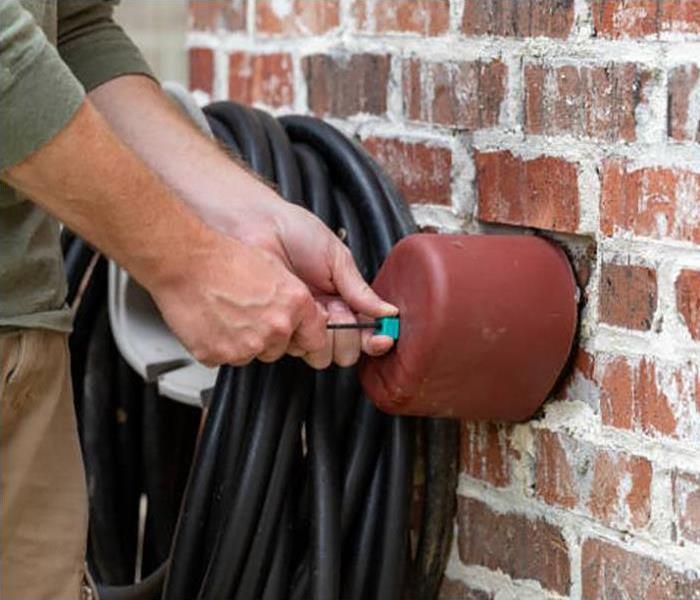 Protect the pipes! Frozen pipes can burst during the winter and cause major problems for homeowners.
Protect the pipes! Frozen pipes can burst during the winter and cause major problems for homeowners.
Now is the time to get your home and business ready for the cold season. Winterization is an important process that homeowners should not neglect for their property.
The purpose of winterizing a home is to avoid higher energy costs and any damage caused by cold weather and snow. Here’s how to winterize your home properly so that it can weather the season:
- Clean the Gutters
Gutters are the workhorses of your home’s exterior. They direct rainwater and snow away from your roof to prevent water from seeping in and causing damage. But gutters can’t do this very important job when they’re clogged with dead leaves and other debris. Whether you hire someone to do it for you or climb a ladder yourself, make sure your gutters are clear before the first snowfall.
TIP: A telescoping gutter wand makes it easier and faster to clean your gutters.
- Inspect the Roof and Attic
Now’s the time to make any repairs to your roof so that it won’t leak in the rain or the snow. If you have an attic, replace or add insulation to keep drafts out.
TIP: Be sure to wear gloves whenever you are handling fiberglass insulation.
- Check the Chimney
If you have a fireplace, you’ll want to make sure the chimney is clear of any buildup. A dirty chimney can be a fire hazard, so hire a chimney sweep to ensure it’s clear and you can build fires safely all season.
TIP: If you don’t actively use your fireplace, inflate a chimney balloon and plug up the space to keep out the cold.
- Weatherproof Windows and Doors
Cold air can creep in through windows and doors, so be sure to replace any weatherstripping around them. Apply caulking to seal any gaps around windows—you can also do this for any cracks in the siding, too. Unless you have newer, energy-efficient windows, you can apply window film to keep out the cold. A door sweep installed on the bottom of your door can keep drafts out, too.
TIP: To find the source of a draft, hold a lit candle a couple of inches away from a window or door. If the flame is extinguished, apply caulking or weatherstripping to that spot.
- Protect the Pipes
Frozen pipes can burst during the winter and cause major problems for homeowners. Here are some things you can do to avoid this wintertime nightmare:
-Cover the exterior faucet with an insulated slip-on cover. This will prevent any remaining water from freezing. Exterior pipes should be wrapped with insulation tubing, which can be found at your local hardware store. Do not wrap your pipes with bath towels or newspaper! These coverings hold moisture like a wet rag and defeat the purpose of covering your pipes in the first place.
-Know the location of your main water shutoff so that you can access it quickly in an emergency.
TIP: If you’re going to be away from your home during the winter, be sure to keep your thermostat set to about 55 degrees Fahrenheit. A programmable thermostat makes it easy to keep your house at the right temperature so that your pipes won’t freeze.
- Service the HVAC system
Replace your furnace filter and schedule a service appointment so that your heating system is ready to go before you need it. This might mean scheduling a service call when you’ve got your AC pumping during the summer because service appointments can be hard to get during the height of the season.
TIP: If you live in a climate where there are four distinct seasons, have your HVAC serviced twice a year so that it runs well in both the cold weather and hot weather.
- Prepare Your Patio and Deck
This is particularly important if you live in a region where snow is likely. Cover patio furniture with weatherproof covers or, if possible, store it away in a garage or shed. If your deck is wooden, a fresh coat of sealant will protect it in wet weather.
TIP: Some patio furniture can be left out in the cold weather without being damaged. It all depends on the material used in making it. Teak furniture, for example, can stand up to winter, though furniture made from other types of wood cannot. When in doubt, cover or store your outdoor furniture.
- Ensure Snow Removal Tools Are Accessible
It’s one thing to have a gassed-up snowblower ready and waiting in your shed. But it’s another thing when a snowstorm dumps a foot of snow and you can’t get to it. Well before there is even a single flake in the forecast, be sure that all of your snow removal tools, including shovels and de-icing agents like salt and sand, are out of storage and easily accessible when snow starts to fall. This might be a small task on your winterizing list, but it’s an important one.
TIP: Need new shovels or a snow blower? Buy them any time of year except during the winter, when supplies are low and prices are high. Your best chances to catch a sale will be before or after the snowy season, but know that inventory will likely be limited if you wait until after the winter.
Source: forbes.com





 24/7 Emergency Service
24/7 Emergency Service









